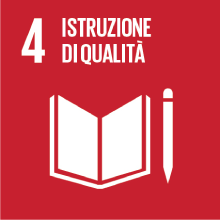MATHEMATICS - 1
- Anno accademico
- 2022/2023 Programmi anni precedenti
- Titolo corso in inglese
- MATHEMATICS - 1
- Codice insegnamento
- ET2018 (AF:383144 AR:208260)
- Lingua di insegnamento
- Inglese
- Modalità
- In presenza
- Crediti formativi universitari
- 6 su 12 di MATHEMATICS
- Livello laurea
- Laurea
- Settore scientifico disciplinare
- SECS-S/06
- Periodo
- 1° Periodo
- Anno corso
- 1
- Sede
- VENEZIA
- Spazio Moodle
- Link allo spazio del corso
Inquadramento dell'insegnamento nel percorso del corso di studio
In "Mathematics I" a particular attention is paid to problems of maximization and minimization of functions of one variable, as preparatory to optimization in multiple variables (discussed in the second part of the course).
Risultati di apprendimento attesi
a) Knowledge and understanding
a.1) Knowledge of basic definitions in calculus in one variable, such as: derivatives, limits, integrals;
a.2) Interpretation of the above definitions in terms of geometric properties, supported by a span of crucial examples.
b) Ability to apply knowledge and understanding
b.1) Ability to compute, for functions of one variable: derivatives, limits, integrals (elementary, by parts, by substitution);
b.2) Ability to analyse properties of functions of one variable, such as monotonicity, convexity, behaviour in the long run;
b.3) Ability to compute stationary and inflection points; ability to maximize/minimize a quantity described by a one variable function, particularly when it describes an economic variable;
b.3) Ability to interpret all above properties in examples of economic/managerial vocation.
c) (Lifelong) learning skills
c.1) Improved ability to handle a formal language, to make logic deductions; enhance rigorous rational thinking;
c.2) Improved ability to translate a problem into formal terms, solve it and interpret the solution in terms of the original problem.
Prerequisiti
Topics usually taught at school of upper secondary education are given as known. In particular: the basics of set theory, real numbers; algebraic operations and properties of real numbers; powers and fractional powers, absolute values; equations and inequalities of first/second order, rational, irrational, exponential and logarithmic type; linear and quadratic functions; exponential and logarithmic functions; elements of analytic geometry: cartesian coordinates, distance of points in the plane, lines, parabolas, ellipses, hyperbolas and their equations and graphs in the plane.
Contenuti
a.1) Definition and geometric interpretation. Rules of differentiation.
a.2) Linear approximation.
a.3) Increasing/decreasing functions.
a.4) Rates of change and applications to economic examples.
a.5) Derivative of the inverse
b) Limits
b.1) Definition. Operations with limits. Indefinite forms.
b.2) L'Hopital’s rule.
b.3) Notable limits. Comparison of infinities of different strengths.
b.4) Change of variables in limits
b.5) One sided limits.
c) Continuous functions
c.1) Definition and examples
c.2) Necessary and sufficient conditions of continuity via left/right limits. Application to piecewise defined functions.
c.3) Intermediate value Theorem and applications.
c.4) Left/Right derivative. Sufficient conditions of differentiability via left and right limits.
c.5) Continuity versus differentiability.
d) Optimization
d.1) Definiton of maximum and minimum point. Stationary points.
d.2) First and second order conditions of optimality.
d.3) Weierstrass Theorem. Optimization on a compact interval.
d.4) Economic examples
e) Concavity/Convexity
e.1) Convex sets.
e.2) Epigraph, hypograph. Definition of convex and concave functions.
e.3) Necessary and sufficient conditions of convexity
e.4) Inflection points. Convexity and second derivatives.
e.5) Examples of notable concave functions in Economics.
f) Integration
f.1) Rules of integration, antiderivatives.
f.2) The Riemann integral, definite integrals. Fundamental theorem of integral calculus. Integral functions.
f.3) Economic examples
f.4) Improper integrals.
Testi di riferimento
In addition, lecture slides, homework and solved exams are made available on the webpage of the course, the university e-learning platform moodle.unive.it, at the page
https://moodle.unive.it/course/view.php?id=8337
Modalità di verifica dell'apprendimento
The exam consists of 6 problems, 3 of which on the topics Mathematics I, and 3 on those of Mathematics II, to be solved in 2h30’ overall. Abilities acquired by students are verified by requiring them to solve the problems. Their acquired knowledge is verified by asking them to justify in detail their answers, on the basis of the theoretical results (definitions and theorems) presented and practised in class during the course.
The exam is closed-notes and closed-book, but students are allowed to use a pocket calculator (scientific calculators computing derivatives and integrals, or plotting graphs, are not allowed).
Students scoring 18/30 or above may register the grade or ask for the optional oral exam. With the oral exam the grade may be raised or diminished. Students scoring between 16/30 and 18/30 also may ask for the optional oral exam, and register grades reaching a minimum of 18/30 (after the orals).
Two partial exams are issued during the course time span, one covering the topics of Mathematics I and one covering those of Mathematics II. A score in each of the partial equal or above 8/30 is considered equivalent to the final written exam, with overall grade equal to the sum of the grades of the partials. (The rules for orals apply similarly).
Samples of Exams with complete solutions are found in
https://moodle.unive.it/course/view.php?id=8337
Modalità di esame
Metodi didattici
In particular, during the course time, office hours are held in public. Students may come and ask questions or simply sit and listen to other students’ questions and to the instructor’s answers. A further discussion is also possible on appointment.
The topics discussed in class are supported by materials made available for download on the webpage of the course https://moodle.unive.it/course/view.php?id=4882 , including:
a) the complete set of slides/lecture notes;
b) weekly sets of homework exercises;
c) a list of previous exams, all completely solved
d) all relevant information about the course, and real time updates.
Altre informazioni
Accessibility, Disability and Inclusion
Accommodation and support services for students with disabilities and students with specific learning impairments
Ca' Foscari abides by Italian Law (Law 17/1999; Law 170/2010) regarding support services and accommodation available to students with disabilities. This includes students with mobility, visual, hearing and other disabilities (Law 17/1999), and specific learning impairments (Law 170/2010). If you have a disability or impairment that requires accommodations (i.e., alternate testing, readers, note takers or interpreters) please contact the Disability and Accessibility Offices in Student Services: disabilita@unive.it.
Obiettivi Agenda 2030 per lo sviluppo sostenibile
Questo insegnamento tratta argomenti connessi alla macroarea "Capitale umano, salute, educazione" e concorre alla realizzazione dei relativi obiettivi ONU dell'Agenda 2030 per lo Sviluppo Sostenibile


